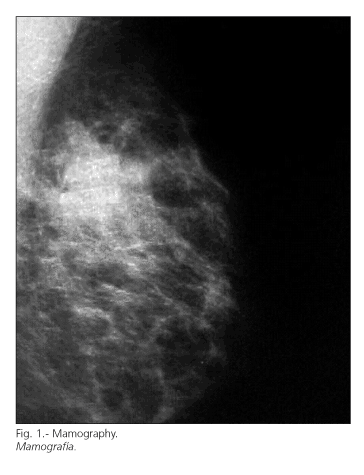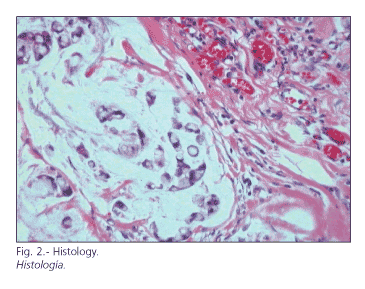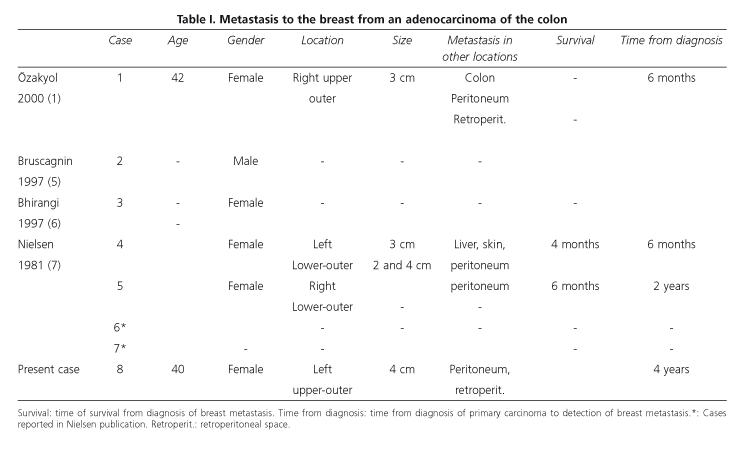Mi SciELO
Servicios Personalizados
Revista
Articulo
Indicadores
-
 Citado por SciELO
Citado por SciELO -
 Accesos
Accesos
Links relacionados
 Citado por Google
Citado por Google -
 Similares en
SciELO
Similares en
SciELO  Similares en Google
Similares en Google
Compartir
Revista Española de Enfermedades Digestivas
versión impresa ISSN 1130-0108
Rev. esp. enferm. dig. vol.96 no.6 Madrid jun. 2004
| CLINICAL NOTES |
Breast metastasis of primary colon cancer
L. Fernández de Bobadilla, A. García Villanueva, M. Collado, A. de Juan, R. Rojo, J. Pérez, E. Lisa, A. Aguilera, A. Mena
and F. González-Palacios1
Department of Digestive and General Surgery, Unit of Mamarian Pathology. 1Department of Pathology.
University Hospital Ramón y Cajal. Madrid. Spain
ABSTRACT
Metastatic tumors to the breast from colon adenocarcinoma are very rare. They are usually indicative of disseminated disease, and the prognosis is poor. Generally, radical operation should be avoided unless needed for palliation. This case report described a patient with breast metastasis from colon adenocarcinoma treated by simple mastectomy.
Key words: Breast metastasis of primary colon cancer. Breast metastases from extramamary malignancies.
Fernández de Bobadilla L, García Villanueva A, Collado M, De Juan A, Rojo R, Pérez J, Lisa E, Aguilera A, Mena A and González-Palacios F. Breast metastasis of primary colon cancer. Rev Esp Enferm Dig 2003; 96: 415-419.
Recibido: 28-07-03.
Aceptado: 29-07-03.
Correspondencia: Lourdes Fernández de Bobadilla Olazábal. C/ Ríos Rosas, 9, 1º B. 28003 Madrid. Telf.: 91 597 42 03. e-mail: lfernandezo.hrc@salud.madrid.org
INTRODUCTION
Metastasis to the breast from an extramammary malignancy is a rare finding. Its clinical incidence varies from 0.5 to 2% (1-3). Within metastatic disease to the breast, colon cancer metastases are rare. The first cases of breast metastasis from an adenocarcinoma of the colon and rectum were reported by McIntosh in 1974 (4). Since then, fewer than 10 cases have been reported in the literature (1,5-7). It is important to distinguish metastatic disease to the breast from primary breast carcinoma in order to avoid unnecessary mutilating surgical treatment.
OBJECTIVE
We report a new case of metastasis to the breast from an adenocarcinoma of the colon, and review the cases reported in the literature.
CASE REPORT
A 40-year-old woman was diagnosed in 1999 with an adenocarcinoma of the right colon, and a right hemicolectomy was performed. Histopathological examination of the tumor revealed a mucinous adenocarcinoma, Dukes' "C" stage. Chemotherapy was started using 5-fluorouracil not associated with folinic acid due to intoler-ance to this component.
One year later, the patient showed a retroperitoneal mass, about 4 centimetres in size. A fine-needle aspiration cytology was confirmatory of colon adenocarcinoma recurrence. An exploratory laparotomy was indicated. At surgery only an incisional biopsy was performed, due to the presence of peritoneal metastases. The patient was treated with chemotherapy, 5-fluorouracil and irinotecam (stopped for intolerance), and capecitabine and Utefos. The retroperitoneal mass was treated with radiotherapy.
In January 2003, a painless 4-centimetre breast mass was found in the upper outer quadrant of the left breast. The patient was in good health, without symptoms of widespread disease. Fine-needle aspiration cytology suggested a metastatic mucosecretor carcinoma of intestinal origin. Mammography showed an ill-defined asymmetric focal dense image with microcalcifications (Fig. 1). Given the patient's previous history of colonic neoplasm, the unusual cytologic findings, and the good health condition of the patient, an incision frozen biopsy was scheduled to rule out metastatic disease to the breast from primary breast carcinoma, in order to choose an adequate surgical procedure. Mastectomy was selected in view of the lesion's size. Frozen biopsy revealed metastasis to the breast from a mucosecretor adenocarcinoma with "signet ring cells" possibly of colonic origin. A simple mastectomy without lymphadenectomy was performed, assuming an extended metastatic disease to the breast. A definitive histopathologic report confirmed metastases to the breast from a mucinous adenocarcinoma of intestinal origin, based on the presence of ductal in situ carcinoma, a colonic type pattern with "signet ring cells", and an immunohistochemical study that was negative for estrogen and progesterone receptors, and GCDFP-15, and positive for CEA cell expression and cytokeratin 20 (CK 20) (Fig. 2).
The patient was subsequently treated with a FOLFOX chemotherapy shedule. Six months after surgery the patient was admitted to hospital in a poor health condition due to disseminated disease, and was then referred for supportive care.
DISCUSSION
Metastases to the breast are very rare. The most common primary tumor is a contralateral breast carcinoma, followed by leukemia, melanoma, lymphoma, and ovary, lung and stomach cancer (2,8). In children, rhabdomyosarcoma is the tumor most commonly associated with breast metastasis (8). Metastasis to the breast from colon adenocarcinoma is rare. Fewer than 10 cases have been reported in the literature (1,4-7) (Table I).
Most metastases present as palpable breast masses that are usually mobile, but occasionally adherent to the skin (9). Rapid growth is characteristic. There is slight left breast predominance, and the most common site is the upper outer quadrant. Only rarely are they multiple or bilateral lesions (8).
Mammographic evaluation can be useful in the differential diagnosis of primary versus secondary breast malignancy. The classic mammographic finding is a rounded, well-circumscribed mass. Typically there is no spiculation, microcalcification, or thickening of the skin. Mammographic evaluation of size correlates well with clinical measurements because the metastatic mass does not cause a surrounding desmoplastic reaction in adjacent normal breast (1,2,3,8). The case presented in this report had an unusual mammographic appearance, due to the presence of microcalcifications. The histopathological differential diagnosis is based on the presence of an in situ component in the proximity of the main tumor in primary breast cancers, but this is inconsistent. In one published report, 11 of 30 mucinous breast carcinomas showed mucinous atypical hyperplasia and in situ ductal carcinoma. Sometimes mucinous breast carcinomas show a ductal infiltrating solid component, the presence of "signet ring cells" being uncommon. Half of primary tumors of the breast are positive for estrogen and progesterone receptors, and most of them show cytoplasmic stain-ing for GCDFP-15. Typically, colorectal carcinomas are positive for CK20, whereas this is exceptional in primary breast carcinoma (10,11).
The surgical treatment of a secondary breast tumor should be both diagnostic and palliative. Generally, excision biopsy is the appropriate treatment and provides adequate local control. Simple mastectomy is sometimes required when the tumor is bulky, deep-seated or painful. Generally a radical operation should be avoided unless needed for palliation (2,8,12).
The prognosis is poor because they are usually indicative of disseminated disease. In most series, more than 80 percent of patients succumb within one year. Prolonged survival occurs mainly in malignancies for which there is effective chemotherapy (7,8). Six months after surgery our patient was admitted to hospital in poor-health conditions due to disseminated disease, and was referred to supportive care.
CONCLUSION
We conclude that metastases to the breast from an adenocarcinoma of the colon are rare. Typically, they are associated with disseminated metastasic disease and imply a poor prognosis. Excision biopsy is usually appropriate and provides adequate local control, but sometimes simple mastectomy is necessary.
REFERENCES
1. Ozakyol AH, Saricam T, Isiksoy S. Breast metastasis of primary colon cancer. Am J Gastroenterol 2000; 95: 2149. [ Links ]
2. Moore DH, Wilson DK, Hurteau JK, et al. Gynecologic cancers metastatic to the breast. J Am Coll Surg 1998; 187: 178-81. [ Links ]
3. Bohman LG, Basset LW, Gold RH, et al. Breast metastases from extramamary malignancies. Radiology 1982; 144: 309-12. [ Links ]
4. McIntosh IH, Hooper AA, Millis RR. Greening WP. Metastatic carcinoma within the breast. Clin Oncology 1976; 2: 393-401. [ Links ]
5. Bruscagnin A. Un caso di metastasi alla mammella maschile da adenocarcinoma del colon. Radiol Med (Torino) 1997; 93: 463-4. [ Links ]
6. Bhirangi KS, Pinto DJ, Crosbie JJ. Solitary breast metastasis from carcinoma of colon. Ulster Med J 1997; 66: 138-9. [ Links ]
7. Nielsen M, Andersen JA, Henriksen FW, et al. Metastases to the breast from extramamary carcinomas. Acta Path Microbiol Scand 1981; 89: 251-6. [ Links ]
8. Chaignaud B, Hall TJ, Powers C, et al. Diagnosis and natural history of extramammary tumors metastatic to the breast. J Am Coll Surg 1994; 179: 49-53. [ Links ]
9. Vergier B, Trojani M, Mascarel I, et al. Metastases to the breast: differential diagnosis from primary breast carcinoma. J Surg Oncol 1991; 48: 112-6. [ Links ]
10. Chinyama CN, Davies JD. Mammary mucinous lesions: Congeners, prevalence and important pathological associations. Histopathology 1996; 29: 533-9. [ Links ]
11. Lagendijk JH, Mullink H, van Diest PJ, et al. Immunohistochemical differentiation between primary adenocarcinomas of the ovary and ovarian metastases of colonic and breast origin. Comparison between stadistical and intuitive approach. J Clin Pathol 1999; 52: 283-90. [ Links ]
12. Hadju SI, Urban JA. Cancers metastatic to the breast. Cancer 1972; 29: 1691-6. [ Links ]











 texto en
texto en 





